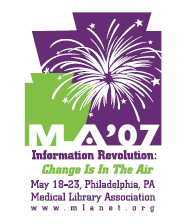This Monday morning session sponsored by the Medical Library Education Section was one of several sessions at MLA this year which had a focus on evidence-based librarianship. Coupled with the "research vignettes" shown before every plenary session, and the revision of the MLA Research Policy Statement, it is clear that the idea that we should all be doing research of our own and strengthening the library science evidence base, is one whose time certainly appears to have come.
I have a confession to make: I spent the first five minutes of this session with several other conference attendees locked in the hall while someone from the Marriott fumbled around with keys.The first speaker was Assako N. Holyoke from Saint Louis University who talked about a study they did to assess the impact of instructors' backgrounds and attitudes on the training of residents. It appeared to be an interesting talk but I couldn't quite get my bearings once I took my seat. I regret it, and I hope to later read about her methodology and results in published form. A few informative articles were mentioned toward the end of her presentation which I can link here:
DiPiro JT. The Best Lecture of the Year. Am J Pharm Ed. 2006 Oct;70(5):108.
Ramos K, Linscheid R, Schafer S. Real-time information seeking behavior of resident physicians. Fam Med. 2003 Apr;35(4):257-60.
Tennant MR, Tobin Cataldo T, Sherwill-Navarro P, Jesano R. Evaluation of a library liaison program: client and liaison perspectives. J Med Libr Assoc. 2006 Oct;94(4):402-9, e201-4.
Martha Preddie followed with a presentation on the state of the evidence base utilizing qualitative research methods, by which she meant research which didn't utilize statistical methods: focus groups, interviews, and the like. She described qualitative research as generally good at answering "why" questions and from Gorman and Clayton, as "facilitating the investigation of complex information environments." To determine the evidence base for qualitative research in our field, Preddie conducted a content analysis of PubMed, finding 84 library research articles utilizing qualitative methods in the period 1996-2006. One thing that she did determine was that the bulk of the research (75%) was 2003-present implying that librarians are doing more research currently. Also, most common methods were interviews and focus groups and most (57%) used mixed methods. The implications are that there continues to be a small evidence base using qualitative methods which are very relevant to our field, that there continues to be difficulty in finding qualitative research studies, and that the methods were not always identified in the abstracts. The implications are that more rsearch using these methods is needed and the LIS curricula need more of a research emphasis.
Joanne Marshall from UNC-Chapel Hill discussed the development of a full-semester course in evidence-based information practice in a Masters LIS program. The textbook used for the course was Booth and Brice's Evidence Based Practice for Information Professionals: A Handbook with guest speakers. They taught the steps of EBLIP which are the same steps we know from EBM: identify a question; find the evidence; appraise the evidence; apply the evidence; evaluate outcomes. In the end they found that they did have enough information for a full-length course. Marshall feels that evidence based library and information practice may be useful in facilitating knowledge transfer between the boomer librarians who will be leaving the field in the next decade or so, and newer entrants to the field who are equipped to conduct research.
Subscribe to:
Post Comments (Atom)

No comments:
Post a Comment